
People Like Us is the stage name of London DJ multimedia artist Vicki Bennett. She has released a number of albums featuring collages of music and sound since 1992. In recent years, she has performed at a number of modern art galleries, festivals and universities.
Locative media or location-based media (LBM) is a virtual medium of communication functionally bound to a location. The physical implementation of locative media, however, is not bound to the same location to which the content refers.

Andy Carvin is an American blogger and a former senior product manager for online communities at National Public Radio (NPR). Carvin was the founding editor and former coordinator of the Digital Divide Network. He is a field correspondent for the vlog Rocketboom.
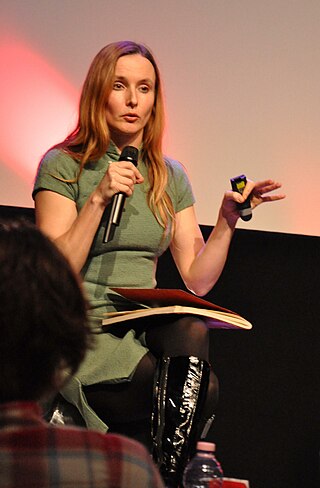
Natalie Jeremijenko is an artist and engineer whose background includes studies in biochemistry, physics, neuroscience and precision engineering. She is an active member of the net.art movement, and her work primarily explores the interface between society, the environment and technology. She has alternatively described her work as "X Design" and herself as a "thingker", a combination of thing-maker and thinker. In 2018, she was Artist in Residence at Dartmouth College, and is currently an associate professor at New York University in the Visual Art Department, and has affiliated faculty appointments in the school's Computer Science and Environmental Studies.
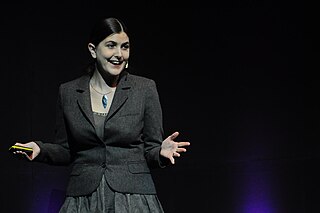
Honor Harger is a curator and artist from New Zealand. Harger has a particular interest in artistic uses of new technologies. She is currently the executive director of the ArtScience Museum in Singapore.

Tiffany Shlain is an American filmmaker, artist, and author. Described by the public radio program On Being as "an internet pioneer", Shlain is the co-founder of the Webby Awards and the founder of the International Academy of Digital Arts and Sciences.

Golan Levin is an American new media artist, composer, performer and engineer interested in developing artifacts and events which explore supple new modes of reactive expression.

Deb Verhoeven is currently the Canada 150 Research Chair in Gender and Cultural Informatics at the University of Alberta. Previously she was Associate Dean of Engagement and Innovation at the University of Technology Sydney, and before this she was Professor of Media and Communication at Deakin University. Until 2011 she held the role of director of the AFI Research Collection at RMIT. A writer, broadcaster, film critic and commentator, Verhoeven is the author of more than 100 journal articles and book chapters. Her book Jane Campion published by Routledge, is a detailed case study of the commercial and cultural role of the auteur in the contemporary film industry.

Ecoarttech is an experimental, postdisciplinary, mixed media environmental art collaborative founded in 2005 by artist Cary Peppermint and literary writer/critic Leila Christine Nadir. The collaborative explores the complex relationships between modernity, technologies, networks, and concepts of nature and culture. Merging primitive with emergent technologies, ecoarttech’s work investigates the overlapping terrain between “nature,” built environments, mobility, and electronic spaces. In furtherfield.org, Sophia Kosmaoglou writes, "Refusing to regard technology merely as a tool, Ecoarttech expand the uses of mobile technology and digital networks revealing them to be fundamental components of the way we experience our environment... By drawing our attention to the increasing replacement or mediation of physical experiences by technology, Ecoarttech challenge the widely reproduced distinction between nature and culture." In visualMAG, Teresa de Andrés describes the artists as "determined to blur the frontiers between city and countryside by using technologies in a creative way... they invite us to lose ourselves in unexplored lands, sinuous urban alleys and arid mountains to the south of the Earth.
Amanda Lenhart is a senior research specialist at the Pew Internet & American Life Project who resides in Washington, D.C. She has published numerous articles and research reports, many of which focus on teenagers and their interactions with the internet and other new media technologies.
Helena Bulaja is a Croatian multimedia artist, film director, scriptwriter, designer and film producer.
Norie Neumark is a sound and media artist who lives and works in Melbourne, Australia. She is part of the art group Out-of-Sync, an art collaboration with Maria Miranda.
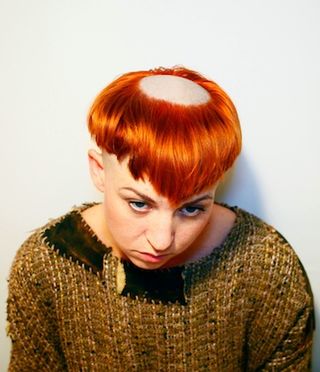
Genevieve Belleveau is an American performance artist and singer based in New York City and Los Angeles. Belleveau is best known for her relational art pieces which involve the audience in the art. She confronts within her work issues of human connection, technology and religious ritual. She was also a driver of a Mister Softee ice cream truck and has managed operations for the Big Gay Ice Cream Truck.

Helen Varley Jamieson is a digital media artist, playwright, performer, director and producer from New Zealand. She "is engaged in an ongoing exploration of the collision between theatre and the internet." Since 1997 she has been working on the internet professionally. In the year 2000 Helen Varley Jamieson coined the term cyberformance. This term is a combination of two words, cyberspace and performance. Jamieson states that "cyberformance can be located as a distinct form within the subsets of networked performance and digital performance, and within the overall form of theatre, as it is a live performance form with an audience that is complicit in the completion of the work in real time."
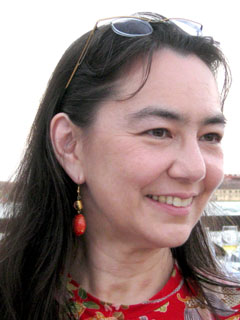
Tamiko Thiel is an American artist, known for her digital art. Her work often explores "the interplay of place, space, the body and cultural identity," and uses augmented reality (AR) as her platform. Thiel is based in Munich, Germany.
Julie Andreyev is a Vancouver-based multidisciplinary artist whose practice explores themes of animal agency and consciousness. Her ongoing Animal Lover work explores nonhuman animal agency and creativity through modes of interspecies collaboration and aleatoric methods. The Animal Lover projects seek to contribute towards an ethic of compassion and regard for the intrinsic worth of other-than-human individuals. She was born in Burnaby, British Columbia.

Laila Shereen Sakr, known by her moniker, VJ Um Amel, is an Egyptian–American digital media theorist and artist. She is the founder of the digital lab, R-Shief, Inc., an Annenberg Fellow, and Assistant Professor of Media Theory & Practice at University of California, Santa Barbara, where she founded the Wireframe digital media studio.

Kim Sawchuk is a professor in the Department of Communication Studies, Research Chair in Mobile Media Studies, and Associate Dean of Research and Graduate Studies at Concordia University in Montreal Canada. A feminist media studies scholar, Sawchuk's research spans the fields of art, gender, and culture, examining the intersection of technology into peoples lives and how that changes as one ages.
Lalya Gaye is a digital media artist and interaction designer whose early work was influential in the field of locative media. Currently based in Newcastle upon Tyne, UK, she is the founder and director of the international and interdisciplinary digital art practice Attaya Projects.
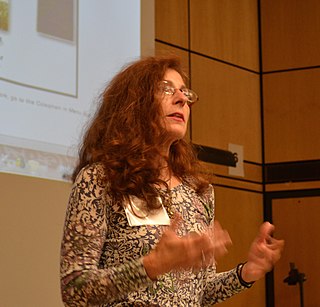
Dene (Rudyne)Grigar is a digital artist and scholar based in Vancouver, Washington. She was the President of the Electronic Literature Organization from 2013 to 2019. In 2016, Grigar received the International Digital Media and Arts Association's Lifetime Achievement Award.













